UGB162 HRM: Motivation Content Theories Application at M&S, 2021
VerifiedAdded on 2023/06/13
|6
|1448
|375
Essay
AI Summary
This essay explores content models of motivation within Human Resource Management, focusing on their practical application at Marks and Spencer. It discusses Maslow's Hierarchy of Needs, Herzberg's Two-Factor Theory, and Alderfer's ERG Theory, analyzing how these frameworks can be used to understand and enhance employee motivation. The essay emphasizes the importance of aligning organizational goals with employee needs to improve productivity and profitability, highlighting the crucial role of HRM in fostering a motivated workforce. Desklib offers additional resources for students studying HRM and related topics.
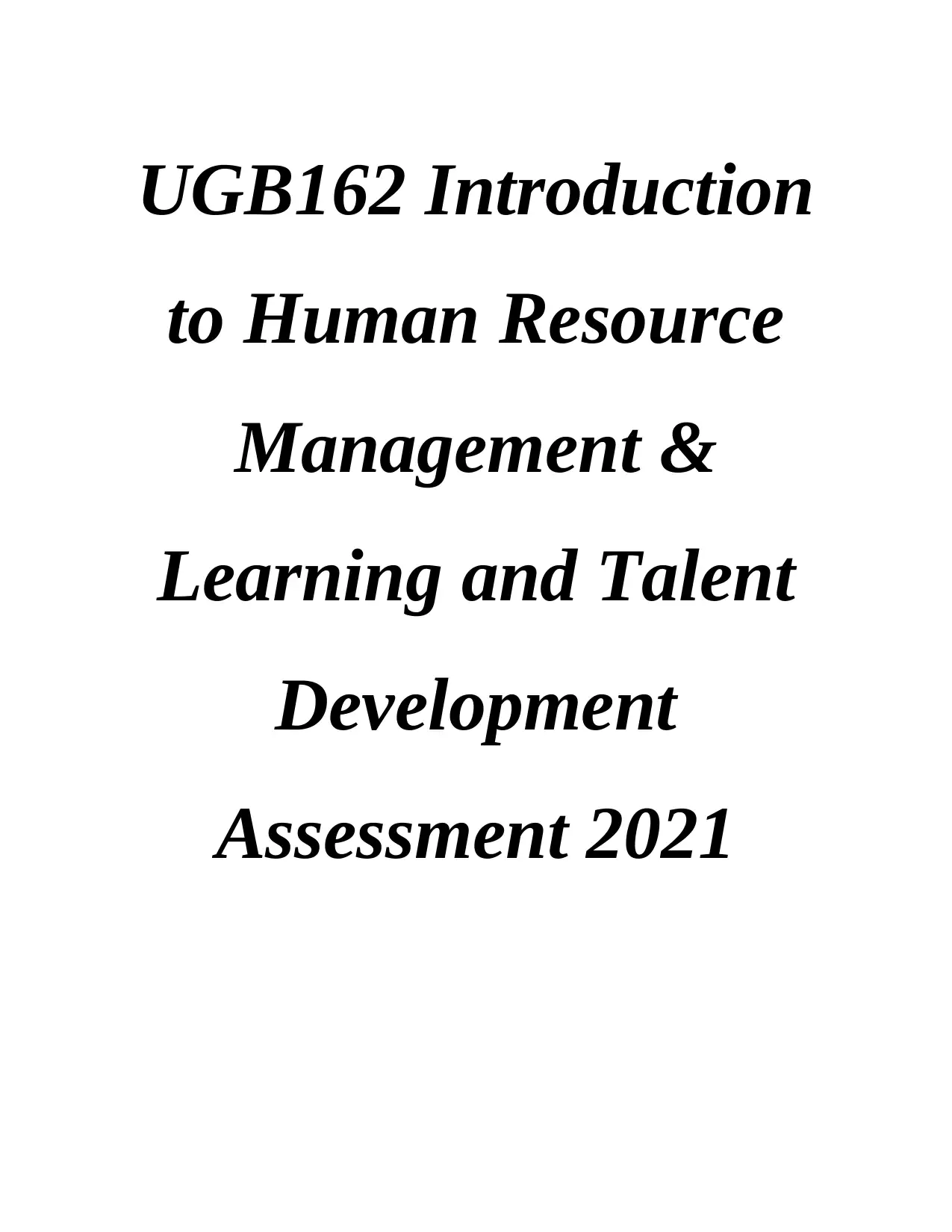
UGB162 Introduction
to Human Resource
Management &
Learning and Talent
Development
Assessment 2021
to Human Resource
Management &
Learning and Talent
Development
Assessment 2021
Paraphrase This Document
Need a fresh take? Get an instant paraphrase of this document with our AI Paraphraser
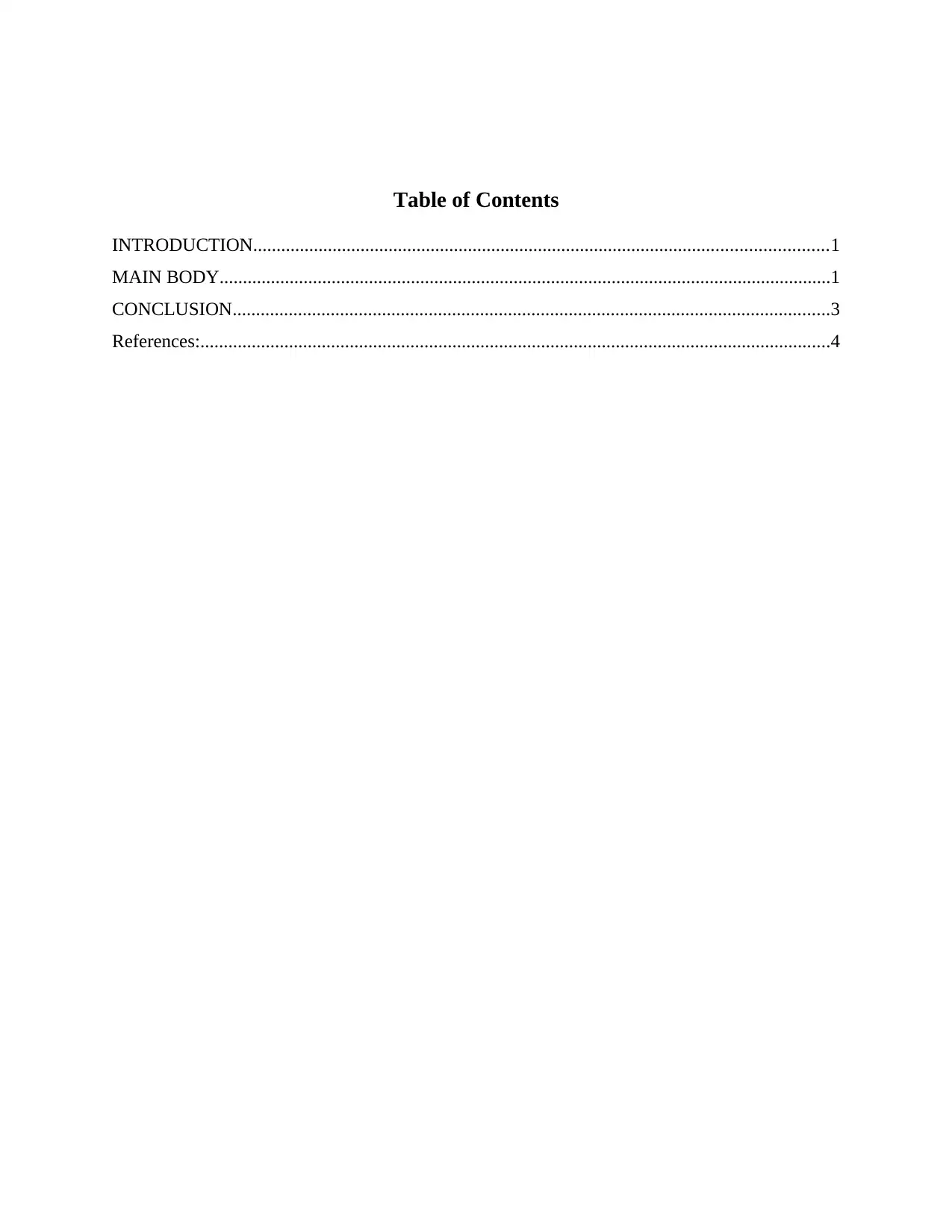
Table of Contents
INTRODUCTION...........................................................................................................................1
MAIN BODY...................................................................................................................................1
CONCLUSION................................................................................................................................3
References:.......................................................................................................................................4
INTRODUCTION...........................................................................................................................1
MAIN BODY...................................................................................................................................1
CONCLUSION................................................................................................................................3
References:.......................................................................................................................................4
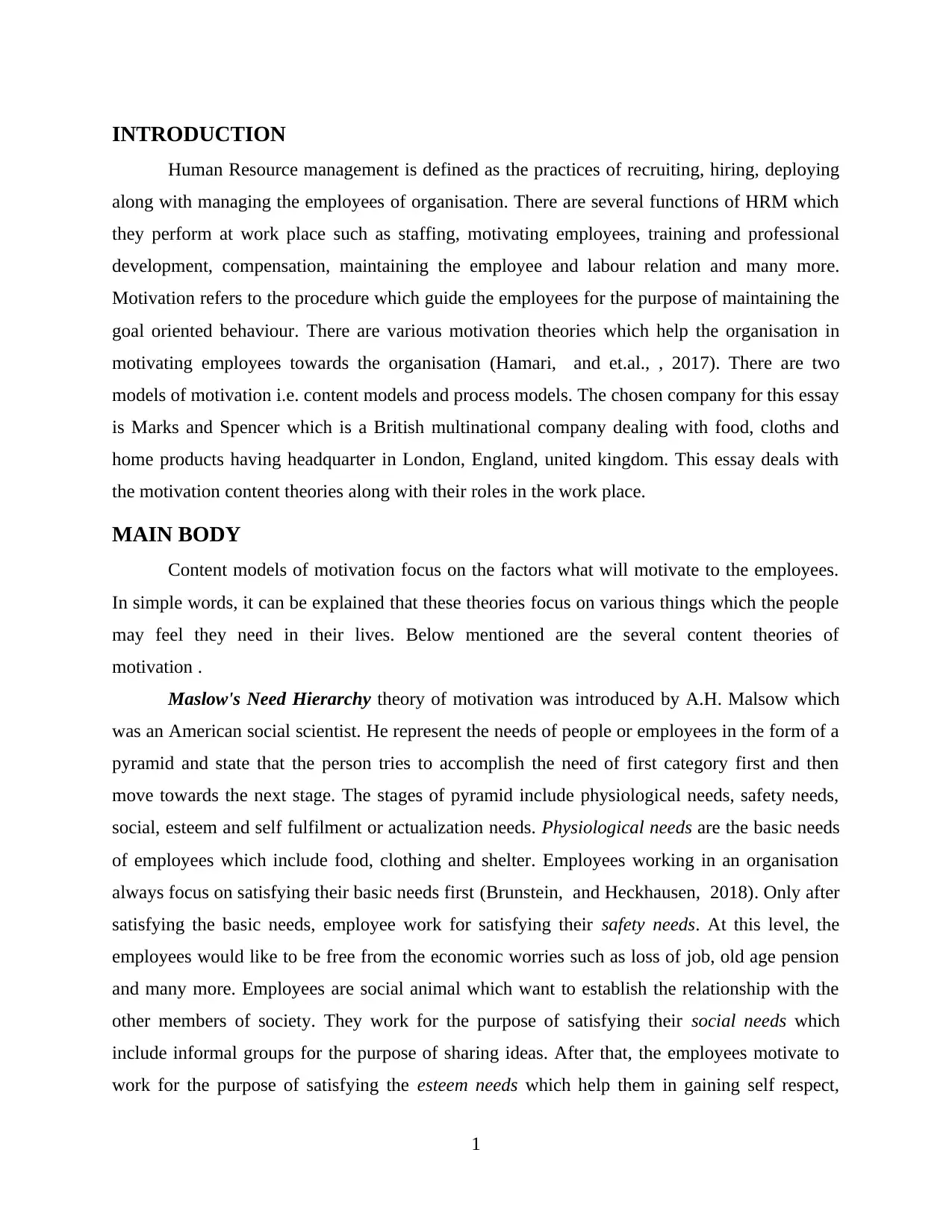
INTRODUCTION
Human Resource management is defined as the practices of recruiting, hiring, deploying
along with managing the employees of organisation. There are several functions of HRM which
they perform at work place such as staffing, motivating employees, training and professional
development, compensation, maintaining the employee and labour relation and many more.
Motivation refers to the procedure which guide the employees for the purpose of maintaining the
goal oriented behaviour. There are various motivation theories which help the organisation in
motivating employees towards the organisation (Hamari, and et.al., , 2017). There are two
models of motivation i.e. content models and process models. The chosen company for this essay
is Marks and Spencer which is a British multinational company dealing with food, cloths and
home products having headquarter in London, England, united kingdom. This essay deals with
the motivation content theories along with their roles in the work place.
MAIN BODY
Content models of motivation focus on the factors what will motivate to the employees.
In simple words, it can be explained that these theories focus on various things which the people
may feel they need in their lives. Below mentioned are the several content theories of
motivation .
Maslow's Need Hierarchy theory of motivation was introduced by A.H. Malsow which
was an American social scientist. He represent the needs of people or employees in the form of a
pyramid and state that the person tries to accomplish the need of first category first and then
move towards the next stage. The stages of pyramid include physiological needs, safety needs,
social, esteem and self fulfilment or actualization needs. Physiological needs are the basic needs
of employees which include food, clothing and shelter. Employees working in an organisation
always focus on satisfying their basic needs first (Brunstein, and Heckhausen, 2018). Only after
satisfying the basic needs, employee work for satisfying their safety needs. At this level, the
employees would like to be free from the economic worries such as loss of job, old age pension
and many more. Employees are social animal which want to establish the relationship with the
other members of society. They work for the purpose of satisfying their social needs which
include informal groups for the purpose of sharing ideas. After that, the employees motivate to
work for the purpose of satisfying the esteem needs which help them in gaining self respect,
1
Human Resource management is defined as the practices of recruiting, hiring, deploying
along with managing the employees of organisation. There are several functions of HRM which
they perform at work place such as staffing, motivating employees, training and professional
development, compensation, maintaining the employee and labour relation and many more.
Motivation refers to the procedure which guide the employees for the purpose of maintaining the
goal oriented behaviour. There are various motivation theories which help the organisation in
motivating employees towards the organisation (Hamari, and et.al., , 2017). There are two
models of motivation i.e. content models and process models. The chosen company for this essay
is Marks and Spencer which is a British multinational company dealing with food, cloths and
home products having headquarter in London, England, united kingdom. This essay deals with
the motivation content theories along with their roles in the work place.
MAIN BODY
Content models of motivation focus on the factors what will motivate to the employees.
In simple words, it can be explained that these theories focus on various things which the people
may feel they need in their lives. Below mentioned are the several content theories of
motivation .
Maslow's Need Hierarchy theory of motivation was introduced by A.H. Malsow which
was an American social scientist. He represent the needs of people or employees in the form of a
pyramid and state that the person tries to accomplish the need of first category first and then
move towards the next stage. The stages of pyramid include physiological needs, safety needs,
social, esteem and self fulfilment or actualization needs. Physiological needs are the basic needs
of employees which include food, clothing and shelter. Employees working in an organisation
always focus on satisfying their basic needs first (Brunstein, and Heckhausen, 2018). Only after
satisfying the basic needs, employee work for satisfying their safety needs. At this level, the
employees would like to be free from the economic worries such as loss of job, old age pension
and many more. Employees are social animal which want to establish the relationship with the
other members of society. They work for the purpose of satisfying their social needs which
include informal groups for the purpose of sharing ideas. After that, the employees motivate to
work for the purpose of satisfying the esteem needs which help them in gaining self respect,
1
⊘ This is a preview!⊘
Do you want full access?
Subscribe today to unlock all pages.

Trusted by 1+ million students worldwide
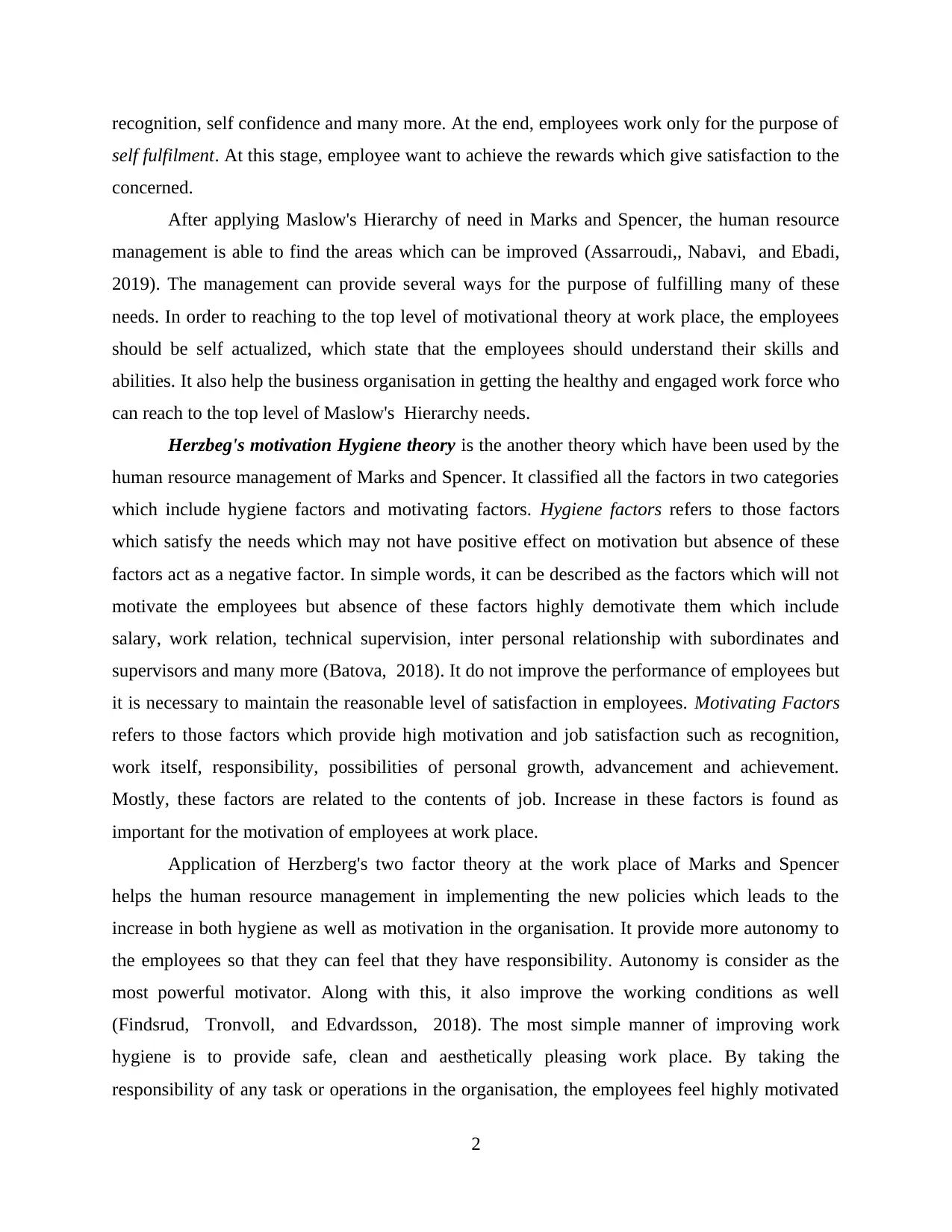
recognition, self confidence and many more. At the end, employees work only for the purpose of
self fulfilment. At this stage, employee want to achieve the rewards which give satisfaction to the
concerned.
After applying Maslow's Hierarchy of need in Marks and Spencer, the human resource
management is able to find the areas which can be improved (Assarroudi,, Nabavi, and Ebadi,
2019). The management can provide several ways for the purpose of fulfilling many of these
needs. In order to reaching to the top level of motivational theory at work place, the employees
should be self actualized, which state that the employees should understand their skills and
abilities. It also help the business organisation in getting the healthy and engaged work force who
can reach to the top level of Maslow's Hierarchy needs.
Herzbeg's motivation Hygiene theory is the another theory which have been used by the
human resource management of Marks and Spencer. It classified all the factors in two categories
which include hygiene factors and motivating factors. Hygiene factors refers to those factors
which satisfy the needs which may not have positive effect on motivation but absence of these
factors act as a negative factor. In simple words, it can be described as the factors which will not
motivate the employees but absence of these factors highly demotivate them which include
salary, work relation, technical supervision, inter personal relationship with subordinates and
supervisors and many more (Batova, 2018). It do not improve the performance of employees but
it is necessary to maintain the reasonable level of satisfaction in employees. Motivating Factors
refers to those factors which provide high motivation and job satisfaction such as recognition,
work itself, responsibility, possibilities of personal growth, advancement and achievement.
Mostly, these factors are related to the contents of job. Increase in these factors is found as
important for the motivation of employees at work place.
Application of Herzberg's two factor theory at the work place of Marks and Spencer
helps the human resource management in implementing the new policies which leads to the
increase in both hygiene as well as motivation in the organisation. It provide more autonomy to
the employees so that they can feel that they have responsibility. Autonomy is consider as the
most powerful motivator. Along with this, it also improve the working conditions as well
(Findsrud, Tronvoll, and Edvardsson, 2018). The most simple manner of improving work
hygiene is to provide safe, clean and aesthetically pleasing work place. By taking the
responsibility of any task or operations in the organisation, the employees feel highly motivated
2
self fulfilment. At this stage, employee want to achieve the rewards which give satisfaction to the
concerned.
After applying Maslow's Hierarchy of need in Marks and Spencer, the human resource
management is able to find the areas which can be improved (Assarroudi,, Nabavi, and Ebadi,
2019). The management can provide several ways for the purpose of fulfilling many of these
needs. In order to reaching to the top level of motivational theory at work place, the employees
should be self actualized, which state that the employees should understand their skills and
abilities. It also help the business organisation in getting the healthy and engaged work force who
can reach to the top level of Maslow's Hierarchy needs.
Herzbeg's motivation Hygiene theory is the another theory which have been used by the
human resource management of Marks and Spencer. It classified all the factors in two categories
which include hygiene factors and motivating factors. Hygiene factors refers to those factors
which satisfy the needs which may not have positive effect on motivation but absence of these
factors act as a negative factor. In simple words, it can be described as the factors which will not
motivate the employees but absence of these factors highly demotivate them which include
salary, work relation, technical supervision, inter personal relationship with subordinates and
supervisors and many more (Batova, 2018). It do not improve the performance of employees but
it is necessary to maintain the reasonable level of satisfaction in employees. Motivating Factors
refers to those factors which provide high motivation and job satisfaction such as recognition,
work itself, responsibility, possibilities of personal growth, advancement and achievement.
Mostly, these factors are related to the contents of job. Increase in these factors is found as
important for the motivation of employees at work place.
Application of Herzberg's two factor theory at the work place of Marks and Spencer
helps the human resource management in implementing the new policies which leads to the
increase in both hygiene as well as motivation in the organisation. It provide more autonomy to
the employees so that they can feel that they have responsibility. Autonomy is consider as the
most powerful motivator. Along with this, it also improve the working conditions as well
(Findsrud, Tronvoll, and Edvardsson, 2018). The most simple manner of improving work
hygiene is to provide safe, clean and aesthetically pleasing work place. By taking the
responsibility of any task or operations in the organisation, the employees feel highly motivated
2
Paraphrase This Document
Need a fresh take? Get an instant paraphrase of this document with our AI Paraphraser
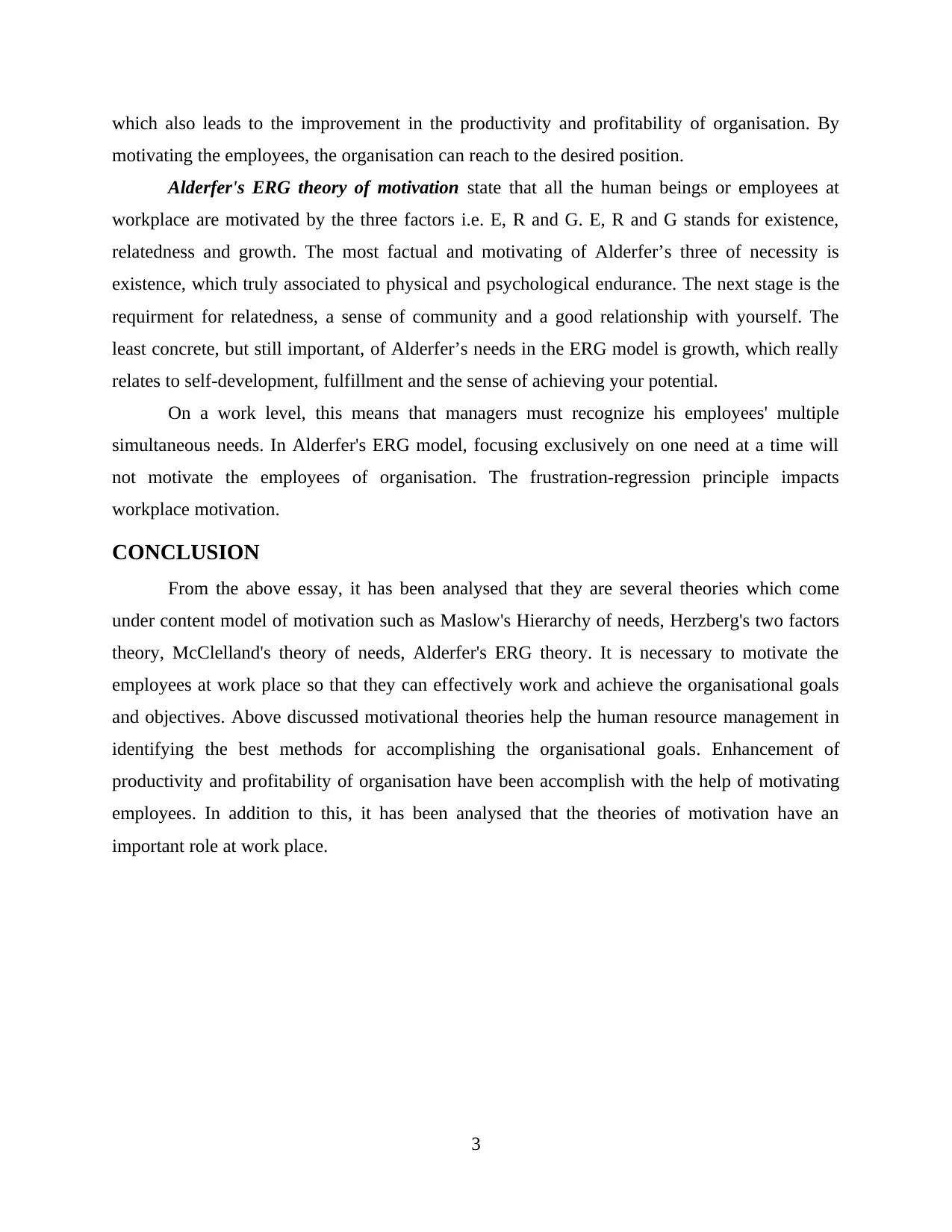
which also leads to the improvement in the productivity and profitability of organisation. By
motivating the employees, the organisation can reach to the desired position.
Alderfer's ERG theory of motivation state that all the human beings or employees at
workplace are motivated by the three factors i.e. E, R and G. E, R and G stands for existence,
relatedness and growth. The most factual and motivating of Alderfer’s three of necessity is
existence, which truly associated to physical and psychological endurance. The next stage is the
requirment for relatedness, a sense of community and a good relationship with yourself. The
least concrete, but still important, of Alderfer’s needs in the ERG model is growth, which really
relates to self-development, fulfillment and the sense of achieving your potential.
On a work level, this means that managers must recognize his employees' multiple
simultaneous needs. In Alderfer's ERG model, focusing exclusively on one need at a time will
not motivate the employees of organisation. The frustration-regression principle impacts
workplace motivation.
CONCLUSION
From the above essay, it has been analysed that they are several theories which come
under content model of motivation such as Maslow's Hierarchy of needs, Herzberg's two factors
theory, McClelland's theory of needs, Alderfer's ERG theory. It is necessary to motivate the
employees at work place so that they can effectively work and achieve the organisational goals
and objectives. Above discussed motivational theories help the human resource management in
identifying the best methods for accomplishing the organisational goals. Enhancement of
productivity and profitability of organisation have been accomplish with the help of motivating
employees. In addition to this, it has been analysed that the theories of motivation have an
important role at work place.
3
motivating the employees, the organisation can reach to the desired position.
Alderfer's ERG theory of motivation state that all the human beings or employees at
workplace are motivated by the three factors i.e. E, R and G. E, R and G stands for existence,
relatedness and growth. The most factual and motivating of Alderfer’s three of necessity is
existence, which truly associated to physical and psychological endurance. The next stage is the
requirment for relatedness, a sense of community and a good relationship with yourself. The
least concrete, but still important, of Alderfer’s needs in the ERG model is growth, which really
relates to self-development, fulfillment and the sense of achieving your potential.
On a work level, this means that managers must recognize his employees' multiple
simultaneous needs. In Alderfer's ERG model, focusing exclusively on one need at a time will
not motivate the employees of organisation. The frustration-regression principle impacts
workplace motivation.
CONCLUSION
From the above essay, it has been analysed that they are several theories which come
under content model of motivation such as Maslow's Hierarchy of needs, Herzberg's two factors
theory, McClelland's theory of needs, Alderfer's ERG theory. It is necessary to motivate the
employees at work place so that they can effectively work and achieve the organisational goals
and objectives. Above discussed motivational theories help the human resource management in
identifying the best methods for accomplishing the organisational goals. Enhancement of
productivity and profitability of organisation have been accomplish with the help of motivating
employees. In addition to this, it has been analysed that the theories of motivation have an
important role at work place.
3

References:
Books and Journals
Batova, T., 2018. Work motivation in the rhetoric of component content management. Journal
of Business and Technical Communication, 32(3), pp.308-346.
Assarroudi, A., Nabavi, F.H. and Ebadi, A., 2019. Motivation for cardiopulmonary
resuscitation: Scale development and psychometric analysis. International emergency
nursing, 45, pp.43-49.
Hamari, J., and et.al., , 2017. Why do players buy in-game content? An empirical study on
concrete purchase motivations. Computers in Human Behavior, 68, pp.538-546.
Brunstein, J.C. and Heckhausen, H., 2018. Achievement motivation. In Motivation and action
(pp. 221-304). Springer, Cham.
Findsrud, R., Tronvoll, B. and Edvardsson, B., 2018. Motivation: The missing driver for
theorizing about resource integration. Marketing Theory, 18(4), pp.493-519.
4
Books and Journals
Batova, T., 2018. Work motivation in the rhetoric of component content management. Journal
of Business and Technical Communication, 32(3), pp.308-346.
Assarroudi, A., Nabavi, F.H. and Ebadi, A., 2019. Motivation for cardiopulmonary
resuscitation: Scale development and psychometric analysis. International emergency
nursing, 45, pp.43-49.
Hamari, J., and et.al., , 2017. Why do players buy in-game content? An empirical study on
concrete purchase motivations. Computers in Human Behavior, 68, pp.538-546.
Brunstein, J.C. and Heckhausen, H., 2018. Achievement motivation. In Motivation and action
(pp. 221-304). Springer, Cham.
Findsrud, R., Tronvoll, B. and Edvardsson, B., 2018. Motivation: The missing driver for
theorizing about resource integration. Marketing Theory, 18(4), pp.493-519.
4
⊘ This is a preview!⊘
Do you want full access?
Subscribe today to unlock all pages.

Trusted by 1+ million students worldwide
1 out of 6
Related Documents
Your All-in-One AI-Powered Toolkit for Academic Success.
+13062052269
info@desklib.com
Available 24*7 on WhatsApp / Email
![[object Object]](/_next/static/media/star-bottom.7253800d.svg)
Unlock your academic potential
Copyright © 2020–2025 A2Z Services. All Rights Reserved. Developed and managed by ZUCOL.



